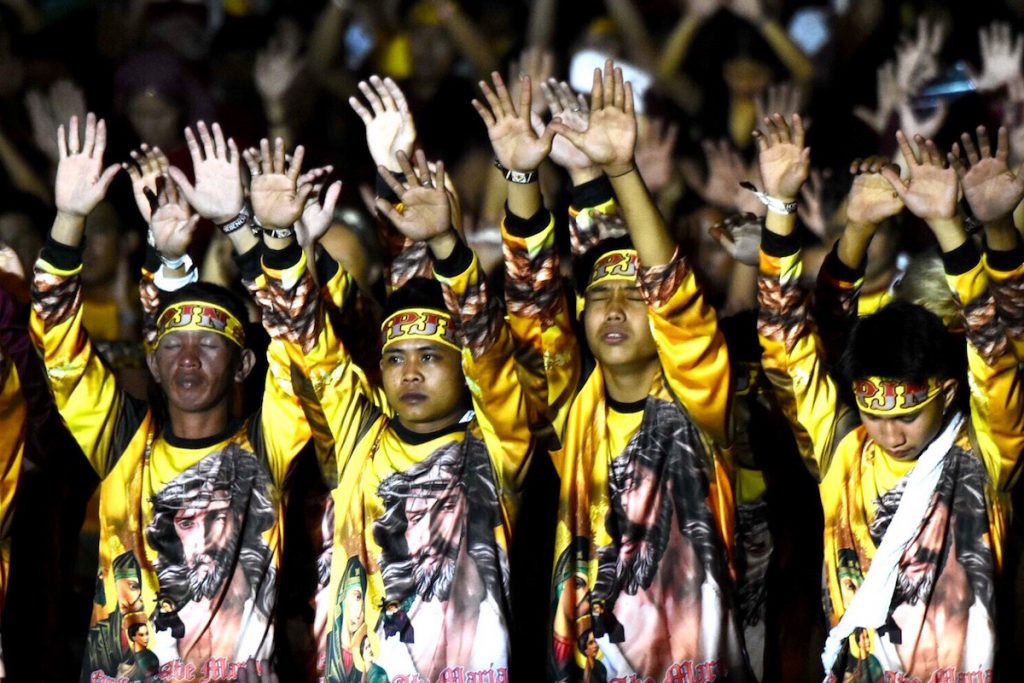The last time Sheryl Andrada attempted to get close and touch the image the Black Nazarene during the annual observance of the “traslación” was seven years ago.
She failed. But on the same year she received her college diploma.
The traslación, which literally means “transfer,” is the largest religious procession in the Philippines, drawing thousands of devotees thronging to touch the image and lasting more than 20 hours.
Along with the Santo Niño or the Child Jesus, the Black Nazarene, a life-size image of a dark-skinned Jesus carrying the cross, is the most popular object of devotion in the country.
Sheryl said she only wanted to get near the carriage of the image during the annual procession when she encounters a “life-changing” event during the year.
The annual procession marks the image’s transfer from a chapel inside the old walled city of Manila to in the city’s Quiapo district.
Sheryl could not recall how her devotion to the Black Nazarene started, but she said her parents used to bring her to join the annual traslación.
This year, the 27-year-old nurse said she would try to brave the sea of the rowdy but good-natured crowd for the last time before leaving the country.
Her petition for a permanent residency in Canada has been granted, and employment that offers a good salary is waiting for her.
“I just felt that I need to say goodbye to the [Black Nazarene]. I prayed to Him to allow me to live abroad and my prayer was heard,” she said.
“I will not see the statue for a long time, although I know that Jesus is present everywhere I go,” added the young lady.
She admitted that she did not want to leave her hometown in Quezon province “if only employment is not a problem here.”


Opportunities abroad
Sheryl is one of the estimated 53 percent of young Filipinos with ages between 15 and 35-years old who expressed willingness to work overseas than in the country based.
Result of a 2019 World Economic Forum survey shows that Filipinos work overseas because of higher salaries while others want to “acquire new skills, pursue a career, and experience other cultures.”
On April 30, 2019, the Philippine Statistics Authority estimated about 2.3 million Filipinos have “worked abroad at any time during the period April to September 2018.”
Workers with existing work contracts comprised 96.2 percent of the total number of overseas Filipino workers while the rest worked overseas without a contract.
Data from the International Labour Organization show that there are about 10 million Filipinos who live abroad and more than a million leave the country each year to work.
Recent government data show that the total number of unemployed persons or those who do not have jobs in the Philippines is 2.05 million as of October 2019.
The unemployment rate in the country averaged 8.24 percent from 1994 to 2019.
Unlike Sheryl, who has the capacity to seek employment abroad, Rodel Cariño has no other option but to pray for “a miracle that someday I will find a decent and secure job.”
He said his prayer used to be simple. “I always pray for good health so that I can work to provide for my family,” he said.
He said he has been a devotee of the Black Nazarene for the past 30 years.
“He gave me good health but still, I can’t find a regular job,” said Rodel.
“Life gets harder and harder each year because there are few job opportunities for so many seekers.” He said he is done “praying for myself or for my health and my family.”
“I think I will pray for a better economy and a better government that can provide us employment,” added the jobless 46-year-old former construction worker.


Extravagant Filipino piety
Jayeel Serrano Cornelio, director of the Development Studies Program at the Jesuit Ateneo de Manila University, said devotion to the Black Nazarene has always attracted the “precariat.”
“The majority of the Black Nazarene devotees are Filipinos who are suffering from a social condition that lacks predictability or security,” he said.
Cornelio said suffering Filipinos relate to the image of the suffering Christ because they are also suffering from social and economic inequalities, or the absence of a better condition, which people think they deserve.
“Suffering does not make Filipinos doubt, rather it makes them more devoted,” said the sociology professor. “Tragedy and suffering are not reasons for them to doubt their faith.”
He described the “extravagant piety” of suffering Filipinos to religious images such as the Black Nazarene as “a cry for liberation” from prevailing social conditions.
Manila Auxiliary Bishop Broderick Pabillo said devotion to the Black Nazarene is “spontaneous.” He said people come to the image of Christ “because they find hope.”
“It is not only the poor who seek the intercession of the Black Nazarene but people from all walks of life — the other [social] classes and those who are longing for change,” he said.
Bishop Ruperto Santos of Balanga said the image of the suffering Christ is a call for the faithful to “stand up and continue the journey.”
“We know that only with sacrifices and sufferings, we are saved, we can save,” he said. “Amidst our brokenness, and even bruised, we are blessed, we can bless others,” added the prelate.
Like the millions of devotees of the Black Nazarene, Sherly and Rodel are ready to take the pain and the bruises every year to get near and touch the image.
They believe, and will continue to believe, that only in their struggle would their prayers be granted, and their agony be taken away.
Watch some raw video footage of the Black Nazarene festivities below.


